

Indian, Pakistani and Chinese border disputes: Fantasy frontiers. South-Asian territorial claims Current boundariesPakistan’s claimChina’s claimIndia’s claim Disputed borders are both a cause and a symptom of tensions between big neighbours in South Asia.
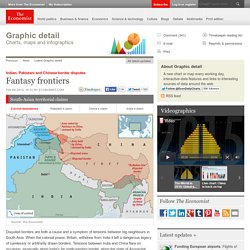
When the colonial power, Britain, withdrew from India it left a dangerous legacy of carelessly or arbitrarily drawn borders. Tensions between India and China flare on occasion, especially along India's far north-eastern border, along the state of Arunachal Pradesh. In recent years Chinese officials have taken to calling part of the same area “South Tibet”, to Indian fury, as that seems to imply a Chinese claim to the territory. Most contentious of all, however, are the borders in Kashmir, where Pakistan, India and China all have competing claims. While Kashmir's Hindu rulers prevaricated, hoping somehow to become an independent country, Pakistan's leaders decided to force the issue.
Forget the South China Sea: Taiwan Could Be Asia's Next Big Security Nightmare. Forget the South China Sea.
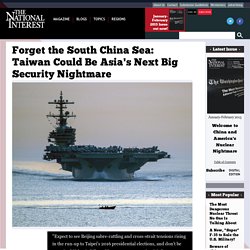
The results of Taiwan’s local elections last week, still reverberating in Beijing, are more likely than not to propel Taiwan’s ascension to the status of No.1 security problem in Asia over the coming two to three years. That is one consequence of the shellacking Taiwan’s ruling KMT party took in last week’s local elections. The ruling KMT lost thirteen of twenty-two cities and counties, including the Mayoralties in Taipei (by an opposition-backed doctor) and Taichung. All told, the opposition Democratic Progressive Party took 47.5 percent of the vote to 40.7 percent garnered by the ruling KMT. Will China accept international law in the South China Sea? Author: Donald R.

Rothwell, ANU The ongoing disputes between the Philippines and China in the South China Sea are about to reach a critical point. In January 2013 the Philippines activated procedures under Article 287 and Annex VII of the 1982 UN Convention on the Law of the Sea (UNCLOS) over a dispute about the validity of China’s ‘nine-dash line’ in the South China Sea. The Philippines contests the validity of this line and any attempts by China to assert sovereignty or sovereign rights over islands and other maritime features found within this area. But will China accept the Annex VII Arbitral Tribunal’s jurisdiction to hear and determine the Philippines’ claim? In 2006 China made a Declaration under Article 298 of UNCLOS indicating that it did not accept certain compulsory dispute resolution procedures under Part XV of the convention, including disputes with respect to ‘historic bays or titles’. The Philippines filed its written pleadings via a memorial on 30 March 2014.
Donald R. Going Anti-Access at Sea: How Japan Can Turn the Tables on China. Chinese ship spies on Valiant Shield — and that’s OK with US - Pacific. YOKOSUKA NAVAL BASE, Japan — A Chinese surveillance ship has been detected observing the Valiant Shield military exercise from within the United States’ exclusive economic zone — a move the U.S. actually doesn’t mind.

One Chinese auxiliary general intelligence vessel has been watching most of Valiant Shield since it began Sept. 15 in and around Guam, military officials said Monday. The exercise, which ends Tuesday, involves 18,000 servicemembers from the Navy, Air Force, Marines and Army simulating combat against each other. Japan angry at Russian army drills on disputed islands.
13 August 2014Last updated at 06:53 ET The islands lie off Japan's northern-most island of Hokkaido Japan says it will strongly protest to Russia over military exercises it is staging on disputed islands off northern Japan.
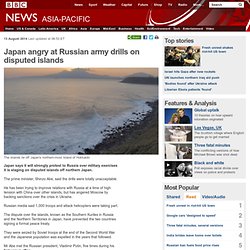
The prime minister, Shinzo Abe, said the drills were totally unacceptable. He has been trying to improve relations with Russia at a time of high tension with China over other islands, but has angered Moscow by backing sanctions over the crisis in Ukraine. Russian media said 1,000 troops and attack helicopters were taking part. Sino-India border dispute best left dormant. Authors: Santosh Sharma Poudel and Stefanie Kam, RSIS The border dispute between China and India has come to the fore once again despite an exponential increase in bilateral trade between the two countries.
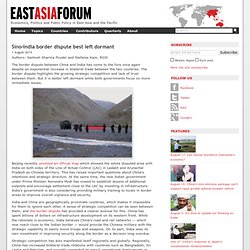
The border dispute highlights the growing strategic competition and lack of trust between them. But it is better left dormant while both governments focus on more immediate issues. Oil rig out, but still no happy ending. Author: Tung Nguyen, Diplomatic Academy of Vietnam.

Japan, China seek to hold summit at APEC in November: media. Old Scores and New Grudges: Evolving Sino-Japanese Tensions. Asia Report N°258 24 Jul 2014 Enmity between China and Japan is hardening into a confrontation that appears increasingly difficult to untangle by diplomacy.
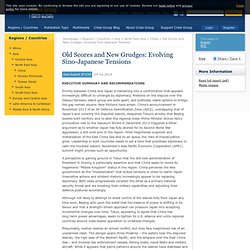
Positions on the dispute over the Diaoyu/Senkaku island group are wide apart, and politically viable options to bridge the gap remain elusive. New frictions have arisen. Recent Trends in the South China Sea and U.S. Policy. The axis of Buddhist extremism. Page 1 of 2 The axis of Buddhist extremism By Tom Farrell The images posted to YouTube and elsewhere on the Internet could hardly be more discordant.

Sitting or reclining, stone or bronze, the serene features on images of the Buddha are strikingly at odds with the taut, anger-charged faces of the shaven-headed men who have recently emerged from various monasteries and shrines to do battle in his name. Their message is straightforward. Nearly a millennium ago, gigantic representations of the Enlightened One smiled down on peoples from Afghanistan to the Pacific. Begotten on the Himalayan foothills during the sixth century BC, two main schools. Asia’s Coming Nuclear Arms Race. The introduction of MIRVed missiles in Asia is likely to prompt a major nuclear arms race in the region.
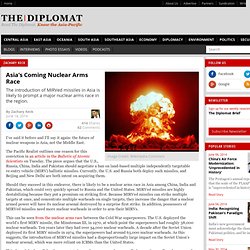
I’ve said it before and I’ll say it again: the future of nuclear weapons is Asia, not the Middle East. The Pacific Realist outlines one reason for this conviction in an article in the Bulletin of Atomic Scientists on Tuesday. The piece argues that the U.S., Russia, China, India and Pakistan should negotiate a ban on land-based multiple independently targetable re-entry vehicle (MIRV) ballistic missiles. Currently, the U.S. and Russia both deploy such missiles, and Beijing and New Delhi are both intent on acquiring them.
Should they succeed in this endeavor, there is likely to be a nuclear arms race in Asia among China, India and Pakistan, which could very quickly spread to Russia and the United States. Www.jfs.tku.edu.tw/18-2/A03.pdf. India’s Nuclear Doctrine: Stirrings of Change. In the beginning of April 2014, at a conference initiated by the Indian government, Manmohan Singh casually urged the creation of a global convention to forswear the first use of nuclear weapons. Why the Indian prime minister chose to make this major policy declaration in the last hours of his term in office is a mystery. To unravel this mystery, it is important to note the context. Singh was addressing a conference at the Institute for Defense Studies and Analyses (IDSA) titled “A Nuclear Weapon-Free World: From Conception to Reality.”
South China Sea Tensions. Introduction Territorial spats over the waters and islands of the South China Sea have roiled relations between China and countries like Philippines, Vietnam, Taiwan, Malaysia, and Brunei in recent years, and tensions continue to escalate in the wake of U.S. President Barack Obama's announced "pivot" of focus to the region. A handful of islands comprise the epicenter of the territorial dispute, making up an area known as the "cow's tongue" that spans roughly the entire South China Sea. The region is home to a wealth of natural resources, fisheries, trade routes, and military bases, all of which are at stake in the increasingly frequent diplomatic standoffs. Vietnam’s deft diplomatic footwork on the South China Sea. Author: Hoang Oanh, RSIS In early May 2014, China deployed the drilling platform Hai Yang Shi You 981 (HYSY 981) in disputed waters in the South China Sea, causing a wave of protest in Vietnam and criticism from regional countries.
In response to China’s behaviour in the South China Sea, Hanoi has been adopting a two-pronged policy of ‘hedging’: that is, pursuing engagement along with indirect balancing and trying to maintain balanced relations between powers without firmly plumping for either. Compared with other countries in the region, Vietnam has been a relative late adopter of this strategy. Its main approach to dealing with China had been engagement. But China’s more hardline approach might push Vietnam toward a more active hedging strategy, and Vietnam’s diplomatic dynamism following the HYSY 981 incident seems to confirm this. After the oil rig deployment incident, Vietnam’s foreign minister called his US counterpart to discuss the issue. Tensions bubble up as China starts drilling. Author: David Brown, California In the aftermath of rioting directed against factories operated by Chinese and other East Asian companies on 12–13 May, Vietnam’s media and blogs were filled with speculation about the cause.
Some opined that Chinese agents were behind the riots, while others guessed that it was provocateurs deployed by the regime. China ships 'rammed 1,400 times by Vietnamese vessels' 9 June 2014Last updated at 00:17 ET Both sides have complained of harassment and intimidation Chinese officials have accused vessels from Vietnam of launching more than 1,400 ramming raids on its ships near a drilling rig in the South China Sea.
The foreign ministry said in a statement the actions were illegal and called on Hanoi to stop "provocations". China moved the drilling rig on 2 May, helping to spark anti-Chinese riots in Vietnam in which four people died. Sources of Tension in the Asia-Pacific: Strategic Competition, Divided Regionalism and Non-traditional Security Challenges. South China Sea: Regional States Push Back Against China. China's Premature Power Play Goes Very Wrong. These are times of mounting drama and tension in the long power play of China’s rise in Asia. Thus, it is more important than ever for American policy makers to peer behind the curtain to see when rising-power loneliness is dressed as leadership and when confidence is a mask for insecurity.
In mid-2014, strategic competition in Asia has become far more than theater. Oil rig incident means Vietnam–China relations face a new test. Author: Le Hong Hiep, Vietnam National University. China Tensions Grow After Vietnamese Ship Sinks in Clash. Vietnam Squares Off With China in Disputed Seas. 'The Regime Could Collapse Quickly' HANOI, Vietnam — When journalist Pham Chi Dung quit Vietnam's Communist Party in December, he was so angry he published his letter of resignation on the Internet.
Factories Torched in Anti-China Protest in Vietnam. Anti-China mobs torched up to 15 foreign-owned factories and trashed many more in southern Vietnam amid rising anger over China's recent placement of an oil rig in disputed Southeast Asian waters, officials and state media said Wednesday. Taiwan and Singapore are paying the price for China’s provocative maritime move - Quartz. Some 19,000 workers in Vietnam rioted yesterday, burning down and damaging as many as 15 factories in an outburst of rage over China’s decision to deploy an oil rig near a disputed chain of islands.
US warns Beijing on South China Sea tensions. 13 May 2014Last updated at 05:27 ET. China responds to Japan–US ‘sushi’ diplomacy. Author: Aurelia George Mulgan, UNSW Canberra The Chinese media exhaustively covered Obama’s visit to Japan on 23–25 April. Rigged relations in the South China Sea. China-Vietnam tensions: Beijing vows to continue drilling. Just How Worrying Is China's Standoff With Vietnam? How Putin Is Reinventing Warfare. Factories Torched in Anti-China Protest in Vietnam.
Taiwan and Singapore are paying the price for China’s provocative maritime move. US warns Beijing on South China Sea tensions. Obama visit fails to strengthen US–Japan trust. Why Obama should abandon the pivot. Role reversal: how Japan became America’s ally and China fell from grace. Build up to WW3 - US and China starting new Cold War? The Asian Cold War. China to conduct naval drills with Russia in East China Sea. Nouriel Roubini says that if the global order blows up, the detonation will occur in Asia.
Obama visits a troubled East Asia. The evolution of Sino–American competition in Myanmar. Challenges for the US-Japan alliance in a changing Asia. India and Pakistan: The Opportunity Cost of Conflict. Obama says US will defend Japan in island dispute with China. Asia-Pacific Pivot: A New Cold War (Just Not the One You Think) The New Silk Road to Nowhere. Fault lines fester in Asia. The Clash of Eurasian Grand Strategies.